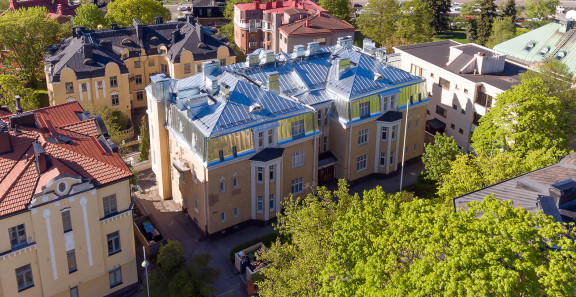As head of the research and inspection department in Sitowise’s renovation unit, Lauri Sinelampi feels that he really is working in the service industry.
Housing companies carry out their projects in the interests of residents. The preparation, planning and implementation of such projects must fit around people’s lives.
Lauri Sinelampi explains
You need time
A year is quite a short time in which to prepare an extensive renovation project from the decisions made at the annual general meeting to the implementation phase.
Lauri Sinelampi regrets that housing companies very rarely reserve enough time to prepare for their renovation projects.
The traditional timing of annual general meetings already causes problems. “Although there is still time to tender out a condition inspection for facade renovations immediately after an annual general meeting in late spring, summer holidays will usually mean that the results can only be discussed in the autumn. And then you will usually still require project planning, permit procedures and briefings for housing company shareholders,” says Lauri Sinelampi, explaining how these projects progress. These days, some housing companies get their shareholders more involved in the preparations – and this also takes time.
It's a good idea to start making enquiries at the earliest possible stage, so that the best contractors are not already booked up for the following summer.
If you have a clear plan for your renovation project, the preparatory, planning and construction phases can be completed within a year. However, two years may be too short a period for larger and more complex projects.
Consider the big picture
Renovating only the facade is usually not the most sensible option for a housing company, even if that was the original intention. It's usually a good idea to renovate or improve other external structures and systems at the same time, such as the roof, windows, balconies, eaves or ventilation. Housing companies should at least determine what kind of renovations would be required and when they are currently scheduled for.
“Simultaneous renovations may also have financial benefits, as residents will not have to live through a number of major renovations in short succession.”
If you are renovating the stormwater systems, it would also be natural to check that the drainage ditches are working properly. “If you do have to dig up yard areas, it’s sensible to do all of the excavation work in one go.”
In older properties, there may be a lot of things that you would like to fix – and then all of a sudden your original project gets out of hand and becomes an enormous renovation programme. “Naturally you can't do absolutely everything at once if it isn't financially feasible. Projects can be scheduled to suit each housing company’s needs,” says Lauri Sinelampi.
Looking to the future
You should take a long-term approach when considering the various options available in a renovation project. This means considering not only the functionality of technical systems but also the needs of residents.
Facade renovations are a good example of this. It's not enough to consider how a property’s newly renovated facade will weather current conditions. You must also be prepared for changes brought about by climate change, such as an increase in driving rain and the long-term durability of concrete structures against stress caused by quickening thawing and freezing cycles.
Although the facade structure may have been perfectly functional when the property was built 40 to 50 years ago, it may no longer be a sustainable solution.
You can also consider the needs of the property’s residents and both their current and future age structure. The age structure of residents in many housing companies is changing, which means that the preparatory and planning phases of renovation projects should also consider things such as accessibility issues, how public areas should be used, and how yard areas should be used and equipped.
What to consider before renovating
Lauri Sinelampi raises some issues that all housing companies should consider and resolve during their renovation projects as far as possible. Many of these will also affect the housing company’s value.
- Lifecycle approaches and environmental issues should be considered during the preparatory phase.
- You should always investigate whether any grants or other financial support are available. This will, however, require further enquiries and sufficient time must be reserved for this.
- You might also be able to receive funding for additional construction, such as additional floors or attic construction. Unfortunately, these opportunities are often ignored in growth centres.
- Stations for charging electric cars need to be reserved in good time.
- Senior citizens should be able to live at home for as long as possible. Renovations can help to promote this by making apartments and public spaces as accessible as possible.
- You can also improve indoor air quality during renovations.
- A facade renovation can enhance comfort by, for example, increasing the amount of natural light and improving indoor air quality.
- Both the project and its success are vital for residents. Comfort currently has a huge impact on the sale prices of apartments, notes Lauri Sinelampi.
Sitowise serves housing companies in over 20 locations across Finland, providing the company’s entire range of expertise in renovation from structural and technical design to acoustics, landscape design, a variety of inspections and reports, and project management and supervision. Dialogue and communication are a key aspect of our work.
Text: Dakota Lavento
